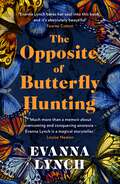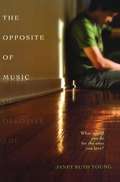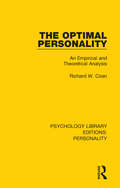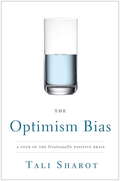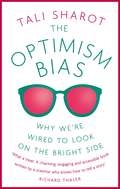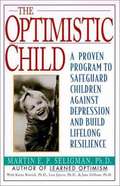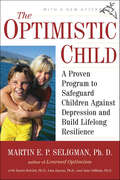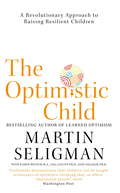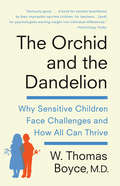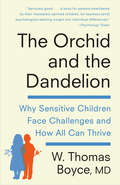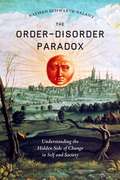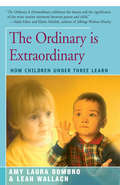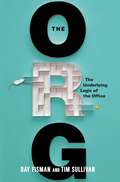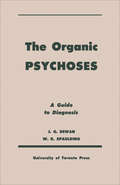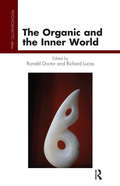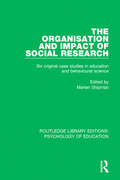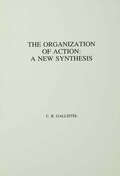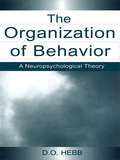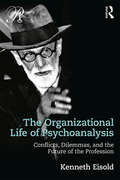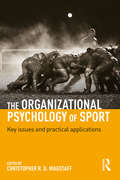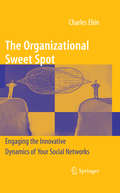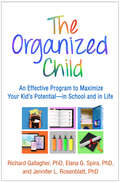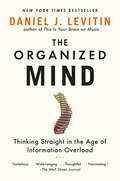- Table View
- List View
The Opposite of Butterfly Hunting: The Tragedy and The Glory of Growing Up: A Memoir
by Evanna Lynch'As well as charting her adolescent battle with anorexia, it offers a darkly compelling, highly topical account of journeying from girlhood to womanhood in the spotlight of global celebrity.' The Mail on Sunday'A raw and powerful memoir, it shares lessons banishing self-hatred.' The Sunday Telegraph'Gradually, I began to feel this dawning awareness that womanhood was coming for me, that it was looming inevitably, and it didn't feel safe...' Evanna Lynch has long been viewed as a role model for people recovering from anorexia and the story of her casting as Luna Lovegood in the Harry Potter films has reached almost mythic proportions. Here, in her fascinating new memoir, Evanna confronts all the complexities and contradictions within herself and reveals how she overcame a life-threatening eating disorder, began to conquer her self-hate and confronted her fear of leaving the neatness and safety of girlhood for the unpredictable journey of being a woman, all in the glare of the spotlight of international fame.Delving into the very heart of a woman's relationship with her own body, Evanna explores the pivotal moments and choices in her life that led her down the path of creativity and dreaming and away from the empty pursuit of perfection, and reaches towards acceptance of the wild, sensual and unpredictable reality of womanhood. This is a story of the tragedy and the glory of growing up, of mourning girlhood and stepping into the unknown, and how that act of courage is the most magical and creatively liberating thing a woman can do.
The Opposite of Music
by Janet Ruth Youngwhen i am well i will take you At first Billy's father just seemed distant, as if he had something on his mind. Then he stopped listening to music, saying it hurt his ears. After a while he stopped eating and sleeping. And after that he just stopped. Stopped being Billy's father and his friend and became someone else. Someone who was depressed and withdrawn and wouldn't respond to treatments. Determined to help their father, Billy and his family devise a series of unconventional therapies for him. But the strain of looking after Dad begins to wear on them all. Billy stops writing songs and starts avoiding his friends. His sister wants to suicide-proof the house. And his mother worries about losing her job because she takes so much time off. Taking care of Dad is starting to sap the strength they need to keep him alive. The Opposite of Music is a powerful and realistic debut novel about the lengths a family will go to in order to save one of their own, and the strength it takes to learn how to ask for help.
The Optimal Personality: An Empirical and Theoretical Analysis (Psychology Library Editions: Personality)
by Richard W. CoanThe terms mental health, maturity, personality integration, self-actualization have been used by psychologists to represent the realm of the ideal or optimal personality. Originally published in 1974, Professor Richard Coan here describes a method of analysing this domain, and examines the important theoretical implications of his findings. He developed instruments to measure various characteristics, including personal consistency, the experience of control and openness to experience, which are associated with current concepts of sound psychological functioning. A battery containing these instruments was administered to several hundred subjects and analysed. The results, reported here, are enlightening. It was found, for example, that the different characteristics viewed by psychologists as traits of the ideal person do not constitute a unitary pattern. There is no evidence of a general dimension of personality integration or mental health. A number of independent components or factors of sound functioning were isolated. Some desirable traits were discovered to be inversely related to each other, many of these relationships appearing to involve a choice between an open or spontaneous orientation and a more ordered and controlled orientation. The author’s view, fully supported by his findings, is that if people are to achieve maximal realization of their potentials, a clear requisite is the flexible utilization of various modes of experiencing and acting.
The Optimism Bias
by Tali SharotFrom a leading neuroscience researcher, an exploration of the neural basis of optimism, and how the brain simulates the future. How does the brain generate hope? How does it trick us into moving forward? What happens when it fails? How do the brains of optimists differ from those of pessimists? Psychologists have long been aware that most people tend to entertain an irrationally positive outlook on their lives. Optimism may be so crucial to our existence that it is hard-wired into our brains. With the emergence of MRI brain imaging, we are beginning to understand the neural mechanisms and to understand the biological basis of optimism, and how our optimistic illusions affect our financial, professional and emotional decisions.From the Hardcover edition.
The Optimism Bias: Why we're wired to look on the bright side
by Tali SharotWinner of the British Psychological Society Book Award for Popular PsychologyPsychologists have long been aware that most people tend to maintain an irrationally positive outlook on life. In fact, optimism may be crucial to our existence. Tali Sharot's original cognitive research demonstrates in surprising ways the biological basis for optimism. In this fascinating exploration, she takes an in-depth, clarifying look at how the brain generates hope and what happens when it fails; how the brains of optimists and pessimists differ; why we are terrible at predicting what will make us happy; how anticipation and dread affect us; and how our optimistic illusions affect our financial, professional, and emotional decisions.With its cutting-edge science and its wide-ranging and accessible narrative, The Optimism Bias provides us with startling new insight into how the workings of the brain create our hopes and dreams.
The Optimistic Child
by Martin E. P. Seligman Karen Reivich Lisa Jaycox Jane GillhamThe optimistic child : a proven program to safeguard children against depression and build lifelong resilience.
The Optimistic Child: A Proven Program to Safeguard Children Against Depression and Build Lifelong Resilience
by Karen Reivich Lisa Jaycox Jane Gillham Martin E. SeligmanNew York Times bestselling author Martin E. P. Seligman's The Optimistic Child is "the first major work to provide an effective program for preventing depression in childhood — and probably later in life" (Aaron T. Beck, author of Love is Never Enough).The epidemic of depression in America strikes 30% of all children. Now Martin E. P. Seligman, the bestselling author of Learned Optimism, and his colleagues offer parents and educators a program clinically proven to cut that risk in half. With this startling research, parents can teach children to apply optimism skills that can curb depression, boost school performance, and improve physical health. These skills provide children with the resilience they need to approach the teenage years and adulthood with confidence. For more than thirty years the self-esteem movement has infiltrated American homes and classrooms with the credo that supplying positive feedback, regardless of the quality of performance, will make children feel better about themselves. But in this era of raising our children to feel good, the hard truth is that they have never been more depressed. As Dr. Seligman writes in this provocative new book, "Teaching optimism is more than, I realized, than just correcting pessimism...It is the creation of a positive strength, a sunny but solid future-mindedness that can be deployed throughout life — not only to fight depression and come back from failure, but also to be the foundation of success and vitality."
The Optimistic Child: A Revolutionary Approach to Raising Resilient Children
by Martin SeligmanFrom the bestselling author of Authentic HappinessIn The Optimistic Child, Dr. Martin Seligman offers parents, teachers and coaches a well-validated program to prevent depression in children. Seligman shows adults how to teach children the skills of optimism that can help them combat sadness, achieve more on the playing field and at school and improve their physical health. Learning the skills of optimism not only reduces the risk of depression but boosts school performance and provides children with the self-reliance they need as they approach the teenage years and beyond. Filled with practical advice and written in clear, helpful language, this book is an invaluable resource for people who want to open up the world for children.
The Oracle of Night: The History and Science of Dreams
by Daniel Hahn Sidarta RibeiroA groundbreaking history of the human mind told through our experience of dreams—from the earliest accounts to current scientific findings—and their essential role in the formation of who we are and the world we have made. What is a dream? Why do we dream? How do our bodies and minds use them? These questions are the starting point for this unprecedented study of the role and significance of this phenomenon. An investigation on a grand scale, it encompasses literature, anthropology, religion, and science, articulating the essential place dreams occupy in human culture and how they functioned as the catalyst that compelled us to transform our earthly habitat into a human world. From the earliest cave paintings—where Sidarta Ribeiro locates a key to humankind&’s first dreams and how they contributed to our capacity to perceive past and future and our ability to conceive of the existence of souls and spirits—to today&’s cutting-edge scientific research, Ribeiro arrives at revolutionary conclusions about the role of dreams in human existence and evolution. He explores the advances that contemporary neuroscience, biochemistry, and psychology have made into the connections between sleep, dreams, and learning. He explains what dreams have taught us about the neural basis of memory and the transformation of memory in recall. And he makes clear that the earliest insight into dreams as oracular has been elucidated by contemporary research. Accessible, authoritative, and fascinating, The Oracle of Night gives us a wholly new way to understand this most basic of human experiences.
The Orchid and the Dandelion: Why Some Children Struggle and How All Can Thrive
by W. Thomas BoyceFrom one of the world's foremost researchers and pioneers of pediatric health--a book that offers hope and a pathway to success for parents, teachers, psychologists, pyschiatrists, and child development experts coping with "difficult" children. A book that fully explores the author's revolutionary discovery about childhood development, parenting, and the key to helping all children find happiness and success.In The Orchid and the Dandelion, Dr. W. Thomas Boyce writes of the "dandelion" child (hardy, resilient, healthy), able to survive and flourish under most circumstances, and the "orchid" child (sensitive, susceptible, fragile), who, given the right support, can thrive as much as, if not more than, other children. For the past four decades Boyce has been working with troubled children. The Orchid and the Dandelion offers help to those who have lost their confidence in the promise of a child gone seriously adrift--into drug abuse, delinquency, depression, or destructive friendships, the dark territory of psychological trouble, school failure, or criminality.Boyce's breakthrough research reveals how genetic makeup and environment shape behavior. Rather than seeing this "risk" gene as a liability, through his daring research, Boyce has recast the way we think of human frailty and shows that while variant genes can create problems (susceptibility to depression, anxiety, attention deficit hyperactivity disorder, and antisocial, sociopathic, or violent behaviors), they can also, in the right setting and with the right nurturing, produce children who not only do better than before but far exceed their peers. He describes what it is to be an "orchid" child, to live a life far more intense, painful, vivid, and variable than that of a dandelion. For orchid children, the world is often a frightening and overwhelming place. He makes clear that orchids are not failed dandelions and shows people how to embrace the unique gifts, abilities, and strengths of orchid children and how to create and environment at home and work that will allow them to flourish.Boyce writes, as well, of dandelions: how vital they are to what George Eliot describes as "the growing good of the world," even in the midst of their own struggles and life challenges. He writes of his own family, particularly of his sister, the inspiration for his work, an orchid child overcome by the family's tragedies and sadnesses to which the author, as a dandelion child, was impervious.And we come to understand that beneath the servicable categories of "orchid" and "dandelion" lies the truer reality of a continuum, a spectrum of sensitivities to the world, along which we all have a place.
The Orchid and the Dandelion: Why Some Children Struggle and How All Can Thrive
by W. Thomas BoyceFrom one of the world's foremost researchers and pioneers of pediatric health--a book that offers hope and a pathway to success for parents, teachers, psychologists, psychiatrists, and child development experts coping with "difficult" children, fully exploring the author's revolutionary discovery about childhood development, parenting, and the key to helping all children find happiness and success."Based on groundbreaking research that has the power to change the lives of countless children--and the adults who love them."--Susan Cain, author of Quiet: The Power of Introverts. In Tom Boyce's extraordinary new book, he explores the "dandelion" child (hardy, resilient, healthy), able to survive and flourish under most circumstances, and the "orchid" child (sensitive, susceptible, fragile), who, given the right support, can thrive as much as, if not more than, other children. Boyce writes of his pathfinding research as a developmental pediatrician working with troubled children in child-development research for almost four decades, and explores his major discovery that reveals how genetic make-up and environment shape behavior. He writes that certain variant genes can increase a person's susceptibility to depression, anxiety, attention deficit hyperactivity disorder, and antisocial, sociopathic, or violent behaviors. But rather than seeing this "risk" gene as a liability, Boyce, through his daring research, has recast the way we think of human frailty, and has shown that while these "bad" genes can create problems, they can also, in the right setting and the right environment, result in producing children who not only do better than before but far exceed their peers. Orchid children, Boyce makes clear, are not failed dandelions; they are a different category of child, with special sensitivities and strengths, and need to be nurtured and taught in special ways. And in The Orchid and the Dandelion, Boyce shows us how to understand these children for their unique sensibilities, their considerable challenges, their remarkable gifts.
The Orchid and the Dandelion: Why Some Children Struggle and How All Can Thrive
by W. Thomas BoyceFrom one of the world's foremost researchers and pioneers of pediatric health--a book that offers hope and a pathway to success for parents, teachers, psychologists, pyschiatrists, and child development experts coping with "difficult" children. A book that fully explores the author's revolutionary discovery about childhood development, parenting, and the key to helping all children find happiness and success.In The Orchid and the Dandelion, Dr. W. Thomas Boyce writes of the "dandelion" child (hardy, resilient, healthy), able to survive and flourish under most circumstances, and the "orchid" child (sensitive, susceptible, fragile), who, given the right support, can thrive as much as, if not more than, other children. For the past four decades Boyce has been working with troubled children. The Orchid and the Dandelion offers help to those who have lost their confidence in the promise of a child gone seriously adrift--into drug abuse, delinquency, depression, or destructive friendships, the dark territory of psychological trouble, school failure, or criminality.Boyce's breakthrough research reveals how genetic makeup and environment shape behavior. Rather than seeing this "risk" gene as a liability, through his daring research, Boyce has recast the way we think of human frailty and shows that while variant genes can create problems (susceptibility to depression, anxiety, attention deficit hyperactivity disorder, and antisocial, sociopathic, or violent behaviors), they can also, in the right setting and with the right nurturing, produce children who not only do better than before but far exceed their peers. He describes what it is to be an "orchid" child, to live a life far more intense, painful, vivid, and variable than that of a dandelion. For orchid children, the world is often a frightening and overwhelming place. He makes clear that orchids are not failed dandelions and shows people how to embrace the unique gifts, abilities, and strengths of orchid children and how to create and environment at home and work that will allow them to flourish.Boyce writes, as well, of dandelions: how vital they are to what George Eliot describes as "the growing good of the world," even in the midst of their own struggles and life challenges. He writes of his own family, particularly of his sister, the inspiration for his work, an orchid child overcome by the family's tragedies and sadnesses to which the author, as a dandelion child, was impervious.And we come to understand that beneath the servicable categories of "orchid" and "dandelion" lies the truer reality of a continuum, a spectrum of sensitivities to the world, along which we all have a place.
The Order-Disorder Paradox: Understanding the Hidden Side of Change in Self and Society
by Nathan Schwartz-SalantIncreasing order in a system also creates disorder: this seemingly paradoxical idea has deep roots in early cultures throughout the world, but it has been largely lost in our modern lives as we push for increasing systematization in our world and in our personal lives. Drawing on nearly five decades of research as well as forty-five years working as a psychoanalyst, Nathan Schwartz-Salant explains that, in a world where vast amounts of order are being created through the growing success of science and technology, the concomitant disorder is having devastating effects upon relationships, society, and the environment. As a Jungian analyst with training in the physical sciences, Schwartz-Salant is uniquely qualified to explore scientific conceptions of energy, information, and entropy alongside their mythical antecedents. He analyzes the possible effects of created disorder, including its negative consequences for the creator of the preceding order as well as its potentially transformative functions. With many examples of the interaction of order and disorder in everyday life and psychotherapy, The Order-Disorder Paradox makes new inroads into our understanding of the wide-ranging consequences of the order we create and its effects on others and the environment.
The Ordinary is Extraordinary: How Children Under Three Learn
by Amy Laura Dombro Leah WallachToday's parents feel pressured to spend "quality time" preparing their child for success in school and life. This landmark book shows parents how and why everyday moments they share with their child, for instance preparing and eating dinner, giving the child a bath, and changing a child's diaper, are the most valuable educational activities of all.
The Org: The Underlying Logic of the Office
by Tim Sullivan Ray FismanIn THE ORG, Ray Fisman and Tim Sullivan explain the tradeoffs that every organization faces, arguing that this everyday dysfunction is actually inherent to the very nature of orgs. THE ORG diagnoses the root causes of that malfunction, beginning with the economic logic of why organizations exist in the first place, then working its way up through the org's structure from the lowly cubicle to the CEO's office.Woven throughout with fascinating case studies-including McDonald's, al Qaeda, the Baltimore City Police Department, Procter and Gamble, the island nation of Samoa, and Google-THE ORG reveals why the give-and-take nature of organizations, while infuriating, nonetheless provides the best way to get the job done.You'll learn:The purpose of meetings and why they will never go awayWhy even members of al Qaeda are required to submit Travel & Expense reportsWhat managers are good forHow the army and other orgs balance marching in lockstep with fostering innovationWhy it's the hospital administration-not the heart surgeon-who is more likely to save your lifeThat CEOs often spend over 80% of their time in meetings-and why that's exactly where they should be (and why they get paid so much)Looking at life behind the red tape, THE ORG shows why the path from workshop to corporate behemoth is pockmarked with tradeoffs and competing incentives, but above all, demonstrates why organizations are central to human achievement.
The Organic Psychoses: A Guide to Diagnosis
by John Dewan William SpauldingPsychoses due to physical disturbances involving the brain are common and can complicate a bewildering variety of illnesses. Patients with such disorders may be encountered in general practice, emergency wards, medical services, on the surgical ward, post-operatively as well as in psychiatric clinics and of course in mental hospitals. A specialist in psychiatry and a specialist in internal medicine have collaborated to fill an important gap in medical literature of practical value to the physician. Throughout the book the needs of doctors who are responsible for such patients has been kept in mind. In this well-organized, concise monograph the organic psychoses are classified in a comprehensive manner which can be easily applied to clinical cases. The chief diagnostic features of the various organic syndromes have been presented, together with full references to the clinical literature. The diagnostic approach to the various clinical problems has been considered and illustrated by a group of case histories. As teachers, the authors have become aware of the need for a clarification of this complicated area of medicine in order that the practitioner, postgraduate physician, interne, and undergraduate student may have a ready guide to aid him in the diagnosis of these complicated disorders. Many doctors in a number of branches of medical practice will find this a handy, useful book to own.
The Organic and the Inner World (The\psychoanalytic Ideas Ser.)
by Richard Lucas Ronald DoctorThis book considers the place for analytic thinking in the world of psychiatry with its emphasis on an organic approach to major psychiatric disorders. It is the result of a conference that was held at the Institute of Psychoanalysis entitled 'The Organic and the Inner World'.
The Organisation and Impact of Social Research: Six Original Case Studies in Education and Behavioural Sciences (Routledge Library Editions: Psychology of Education)
by Marten ShipmanOriginally published in 1976, the authors of six of the most widely quoted works in behavioural science related to education, at the time, here describe in detail their research work, including its origins, planning and implementation. The accounts are unusual, not only for their technical detail but for their candour. The brief was to put the heart and brains back into accounts of research so the authors comment not only on the research design, but on the personal and professional problems they had to overcome. They also reflect on the reception of their work, and the way in which it has been adapted, misunderstood or deliberately distorted to support arguments of widely differing ideological pressure groups. The book shows how ingenuity and persistence as well as technical competence lie at the heart of the research process. The authors do not give the normal depersonalised, streamlined account which gives a false, mechanical picture of research as an occupation, but show it to be a profound personal and professional experience as they comment on the thought that lay behind their work and the way it was finally produced for publication. Dr Shipman has written a short introduction to each chapter, and contributed a concluding chapter relating the six research experiences to conventional views on the research process and to the part played by research evidence in policy making.
The Organization of Action: A New Synthesis
by C.R. GallistelA synthesis of classic and modern neurobehavioral literature dealing with the principles by which complex, purposive, and intelligent behavior is generated, this book features: * papers by C.S. Sherrington, E. von Holst, D.M. Wilson, G. Fraenkel, H. Mittelstaedt, and P. Weiss * clear descriptions of three types of elementary units of behavior -- the reflex, the oscillator, and the servomechanism * a review of the diverse manifestations of hierarchical structure in the neural mechanisms underlying coordinated action. This volume has proven to be of great value to psychologists, neurobiologists, and philosophers interested in the problem of action and how it may be approached in light of modern neurobehavioral research. It has been designed for use as a supplemental text in courses in physiological psychology, neurobiology and behavior, and those courses in cognitive and developmental psychology that place particular emphasis on understanding how complex behavior patterns are implemented.
The Organization of Behavior: A Neuropsychological Theory
by D.O. HebbSince its publication in 1949, D.O. Hebb's, The Organization of Behavior has been one of the most influential books in the fields of psychology and neuroscience. However, the original edition has been unavailable since 1966, ensuring that Hebb's comment that a classic normally means "cited but not read" is true in his case. This new edition rectifies a long-standing problem for behavioral neuroscientists--the inability to obtain one of the most cited publications in the field. The Organization of Behavior played a significant part in stimulating the investigation of the neural foundations of behavior and continues to be inspiring because it provides a general framework for relating behavior to synaptic organization through the dynamics of neural networks. D.O. Hebb was also the first to examine the mechanisms by which environment and experience can influence brain structure and function, and his ideas formed the basis for work on enriched environments as stimulants for behavioral development. References to Hebb, the Hebbian cell assembly, the Hebb synapse, and the Hebb rule increase each year. These forceful ideas of 1949 are now applied in engineering, robotics, and computer science, as well as neurophysiology, neuroscience, and psychology--a tribute to Hebb's foresight in developing a foundational neuropsychological theory of the organization of behavior.
The Organizational Life of Psychoanalysis: Conflicts, Dilemmas, and the Future of the Profession
by Kenneth EisoldThe Organizational Life of Psychoanalysis is a wide-ranging exploration and examination of the organizational conflicts and dilemmas that have troubled psychoanalysis since its inception. Kenneth Eisold provides a unique, detailed, and closely reasoned account of the systems needed to carry out the tasks of training, quality control, community building, and relationships with the larger professional community. He explores how the freedom to innovate and explore can be sustained in a context where the culture has insisted on certain standards being set and enforced, standards that have little to do with providing effective pathways to cure.? Each chapter in this collection addresses a specific dilemma faced by the profession, including: Who is to be in charge of training and who will determine those who succeed the existing leadership?? Which theories and practices are to be approved and which proscribed and censored?? How is the competition with alternative methods, including psychotherapy informed by psychoanalysis, to be managed?? Several chapters are devoted to exploring the reciprocal influence of Freudian psychoanalysis and Jungian Analytical Psychology. Others explore the specific dilemmas and difficulties affecting the field currently, stemming from the massive restructuring of the health care industry and the changes affecting all professions, as they are reshaped into massive organizations no longer marked by personal relationships and individual control. The Organizational Life of Psychoanalysis will be essential reading for psychoanalysts, psychoanalytic psychotherapists, and anyone interested in the future of psychoanalysis as a profession. It will appeal greatly to anyone who has assumed full or partial responsibility for the management of a psychoanalytic institute or association.
The Organizational Psychology of Sport: Key Issues and Practical Applications
by Christopher R. D. WagstaffThis ground-breaking book is the first to provide a comprehensive overview of how organizational psychology can be used to understand and improve performance in elite sport. Using recent theoretical advances from this burgeoning area of research, each chapter offers key conceptual issues and practical insights across a range of topics. The book is structured into four constituent parts, Attitudes and emotions in sports organizations Stress and well-being in sports organizations Behaviors in sports organizations Environments in sports organizations Covering key areas such as attitudes to employment, conflict and change management, leadership, and relationships with the mass media, the book shines a spotlight on how organizational issues play a fundamental role in the experience of individuals and teams. In an era of ever-increasing professionalism in sport, the book provides an invaluable new perspective on performance at the elite level. Including contributions from an international range of academics and practitioners, it will be essential reading for any student or practitioners within sport and exercise psychology.
The Organizational Sweet Spot
by Charles EhinEmployee disengagement is one of the most pressing problems plaguing managers today hampering the innovation capacities of countless organizations. According to recent polls, some 20 percent of workers report feeling disconnected from their jobs, in an environment of stagnating wages, massive layoffs, rising health care costs, and other factors that contribute to alienation, distrust, and apathy. In The Organizational Sweet Spot, Dr. Charles Ehin takes a refreshing new look at what it will take to reengage disaffected workers and boost their resolve to advance novel ideas. Applying the latest research from such fields as evolutionary psychology, social neuroscience, organizational behavior, anthropology, and social network analysis, Ehin demonstrates how employee disengagement is rooted in a fundamental misalignment between people's instinctive drive to develop their personal and group identities through informal or "emergent" relationships and the ways in which organizational goals and profit motives are executed through formal bureaucracy. The challenge for today's organizations--which operate under constantly changing conditions--is to narrow this gap, that is, to find the "sweet spot", where the formal and informal elements of the organization overlap. Ehin provides practical tools for leaders to support this "shared access domain" to improve productivity, catalyze innovation, and inspire exceptional performance. His new model is likely to reverberate throughout current management thinking as we move toward creating more vital and meaningful workplaces.
The Organized Child: An Effective Program to Maximize Your Kid's Potential--in School and in Life
by Richard Gallagher Elana G. Spira Jennifer L. RosenblattAre you sick of nagging your child to write down homework assignments? Is his or her backpack a black hole that eats up papers, books, and gym clothes? Organizational skills problems aren't just frustrating--they get in the way of school success and wreak havoc at home. Fortunately, help is at hand. This unique resource stands out from other books because it is based on a scientifically tested program that works. Learn how you can teach your 7- to 13-year-old specific skills to: *Organize school materials and toys. *Track assignments. *Improve time management and planning. *Overcome brain "Glitches"--mischievous creatures that trip kids up. *Create and follow effective routines. Concrete examples, tips for strategically using praise and rewards, and practical tools (you can download and print additional copies as needed) help you implement each step of the program. Maximizing your kid's potential starts now--here's how. Mental health professionals, see also the related intervention manual from Gallagher et al., Organizational Skills Training for Children with ADHD: An Empirically Supported Treatment.
The Organized Mind: Thinking Straight in the Age of Information Overload
by Daniel J. LevitinNew York Times bestselling author and neuroscientist Daniel J. Levitin shifts his keen insights from your brain on music to your brain in a sea of details.The information age is drowning us with an unprecedented deluge of data. At the same time, we’re expected to make more—and faster—decisions about our lives than ever before. No wonder, then, that the average American reports frequently losing car keys or reading glasses, missing appointments, and feeling worn out by the effort required just to keep up.But somehow some people become quite accomplished at managing information flow. In The Organized Mind, Daniel J. Levitin, PhD, uses the latest brain science to demonstrate how those people excel—and how readers can use their methods to regain a sense of mastery over the way they organize their homes, workplaces, and time.With lively, entertaining chapters on everything from the kitchen junk drawer to health care to executive office workflow, Levitin reveals how new research into the cognitive neuroscience of attention and memory can be applied to the challenges of our daily lives. This Is Your Brain on Music showed how to better play and appreciate music through an understanding of how the brain works. The Organized Mind shows how to navigate the churning flood of information in the twenty-first century with the same neuroscientific perspective.
